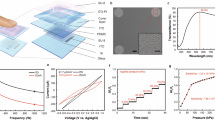Abstract
Haptic interaction with objects, e.g. sculpting with clay, is a fundamental creative activity. To realize such kind of interface with touchscreen, multiple stimulation toward each finger will do. In this research we propose multi-electrode-based electrostatic tactile display and a control method of the charge distribution.
Access provided by CONRICYT-eBooks. Download conference paper PDF
Similar content being viewed by others

Keywords
1 Introduction
In recent years, touchscreen interfaces have become popular worldwide. Moreover, popular consumer electronics devices use a dedicated touchscreen as an interface. However, few touchscreens enable reactive tactile signals.
Several researchers have employed vibrations to display texture information. For example, Chubb et al. [1] developed a tactile display that employs a squeeze film to represent the change in friction. The devices provide simple but rich lateral force to the user’s finger. However, these devices do not consider the rendering method of geometrical shape.
In our previous research, we propose a method of feeling both large bumps and small textures simultaneously on a screen [2]. By employing the technology, users feel geometry as well as texture information. Because this system was based on a string-based haptic display, the system is only for one finger (Fig. 1).
However, our rendering algorithm is easily implemented into other lateral-force-based tactile displays. In recent years other lateral-force-based tactile feedback devices that employ static electric fields have been developed (Senseg, Inc., [3]). By employing the technology, we extend our method to multi-fingered device (Fig. 2).
2 Prototype System
For the first prototype, we use an electrotactile display device (Kajimoto Lab.). The device is designed for direct electrostimulation to fingers. However it outputs 300 V of controlled multiple electrostimulation easily. Based on the device, we design the electrostatic force display. First, we create a single electrode system (Fig. 3). This is made from aluminum foil and 15 \(\mathrm {\upmu m}\) thicknesses of plastic film. With the electrode, we can generate small vibration to the finger.
Next we use a new electrotactile display system (Kajimoto Lab.) By employing the device, we create multiple electrode system (Fig. 3 (Right)). The electrodes are made from aluminum foil and 15 \(\mathrm {\upmu m}\) thicknesses of plastic film. With the electrode, we can confirm stronger vibration to the finger compared to 300 V of electrotactile device. In the next session we tested two displaying methods toward multiple electrodes.
3 Two Displaying Method
3.1 Sinusoidal Wave Input
By employing sinusoidal wave input to every electrodes, and by rubbing every electrodes with the fingers, each finger can feel a small bumps [2]. We can confirm that the conventional displaying method can be used to multiple electrodes, too (Fig. 4).
3.2 Rubbing Between Electrodes
By employing scanning input to every electrodes and rubbing the electrodes with a finger, the vibration can be felt far stronger than the sinusoidal input. This result shows that the edge of multiple electrodes can generate stronger output to the rubbing finger.
4 Conclusions
In this research, we propose to extend our previous method [2] to multi-fingered device with electrostatic display. First, we test the electrostatic force display with simple devices, and design the multiple electrode system. Second, we test multiple electrodes with 600 V output, and confirm the stronger stimulation. By employing sinusoidal input, we can generate a small bumpy surface. By employing scanning input to the electrodes, we can generate stronger output to the rubbing finger. As a next step, we will hold quantitative experiments with the method and develop better stimulation methods with multiple electrodes.
References
Chubb, E.C., Colgate, J.E., Peshkin, M.A.: Shiverpad: a glass haptic surface that produces shear force on a bare finger. IEEE Trans. Haptics 189–198 (2010)
Saga, S., Raskar, R.: Simultaneous geometry and texture display based on lateral force for touchscreen, pp. 437–442 (2013)
Bau, O., Poupyrev, I., Israr, A., Harrison, C.: TeslaTouch: electrovibration for touch surfaces, pp. 283–292. ACM (2010)
Acknowledgements
This work was partly supported by JSPS KAKENHI Grant Number JP16H01662 (Grant-in-Aid for Scientific Research on Innovative Areas, “Innovative SHITSUKSAN Science and Technology”).
Author information
Authors and Affiliations
Corresponding author
Editor information
Editors and Affiliations
Rights and permissions
Copyright information
© 2018 Springer Nature Singapore Pte Ltd.
About this paper
Cite this paper
Tomita, H., Saga, S., Kajimoto, H. (2018). Multi-electrodes-Based Electrostatic Tactile Display. In: Hasegawa, S., Konyo, M., Kyung, KU., Nojima, T., Kajimoto, H. (eds) Haptic Interaction. AsiaHaptics 2016. Lecture Notes in Electrical Engineering, vol 432. Springer, Singapore. https://doi.org/10.1007/978-981-10-4157-0_29
Download citation
DOI: https://doi.org/10.1007/978-981-10-4157-0_29
Published:
Publisher Name: Springer, Singapore
Print ISBN: 978-981-10-4156-3
Online ISBN: 978-981-10-4157-0
eBook Packages: EngineeringEngineering (R0)







